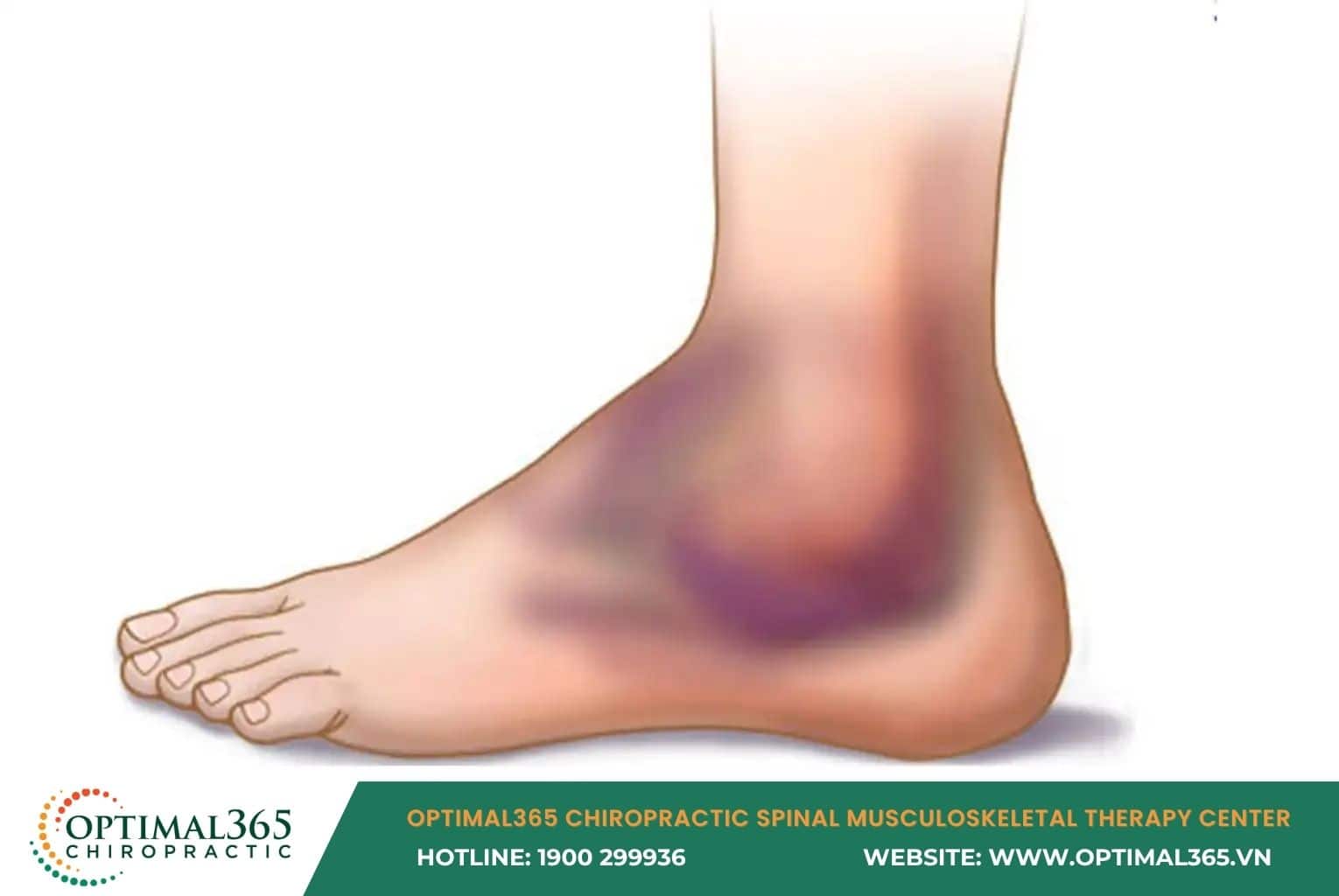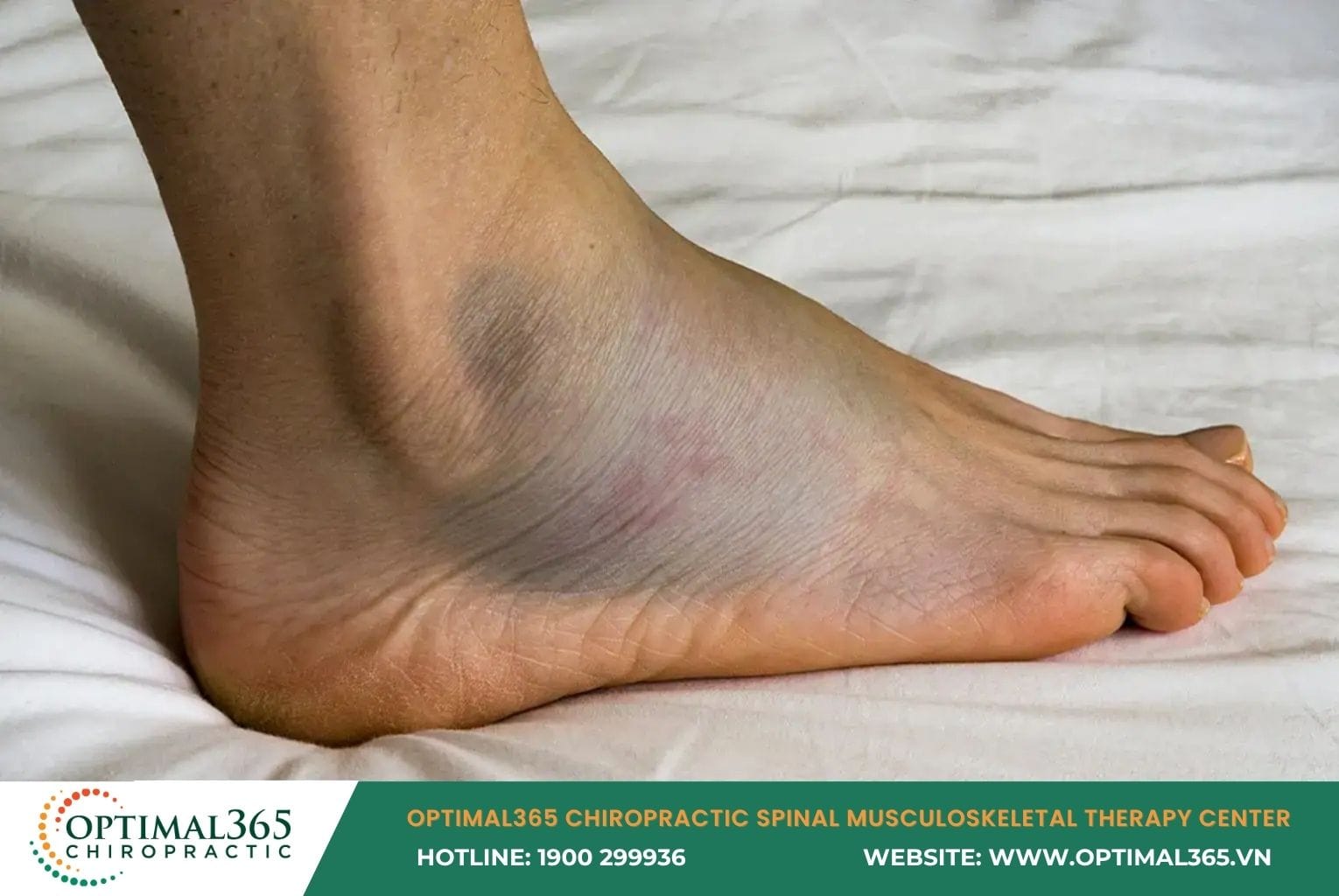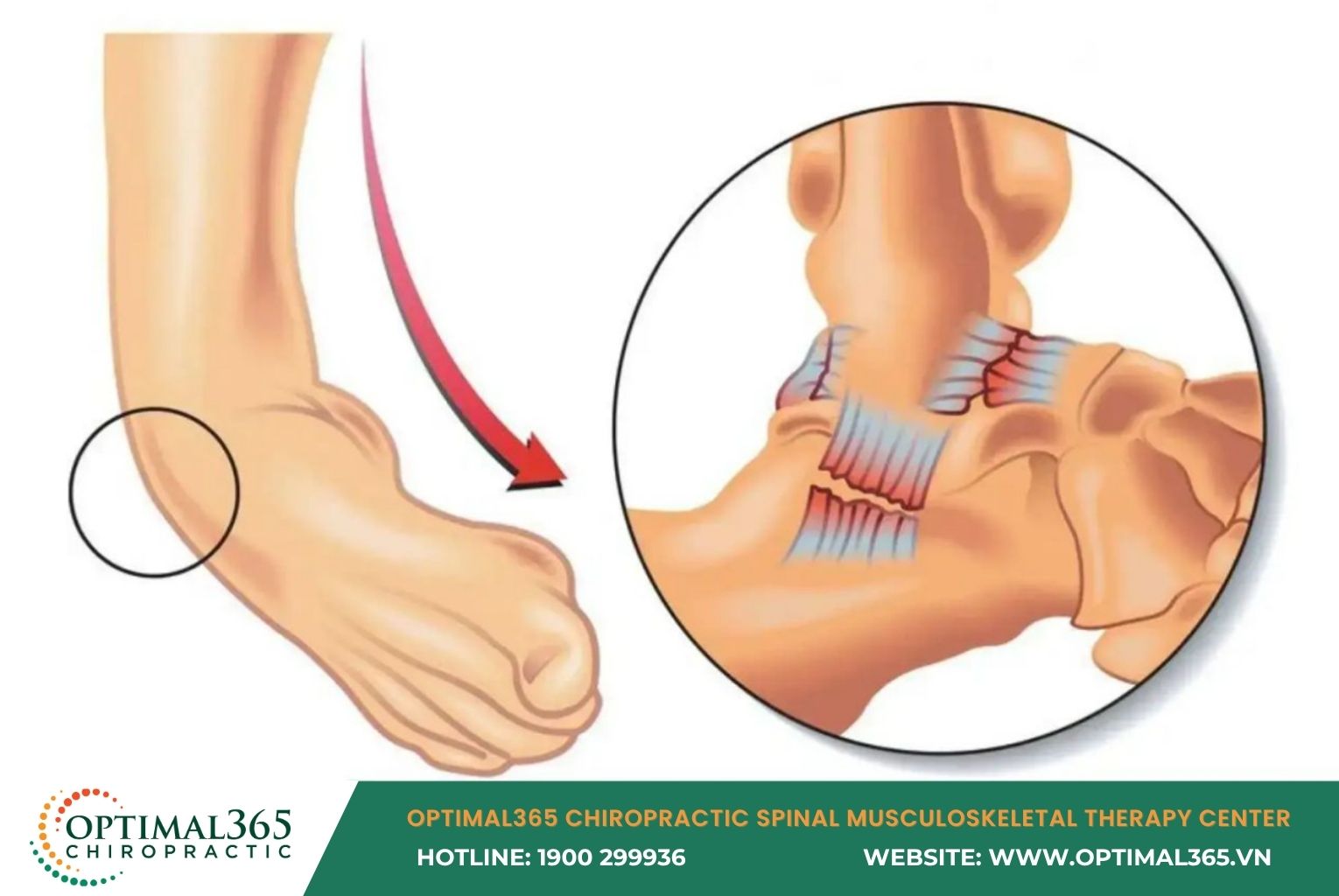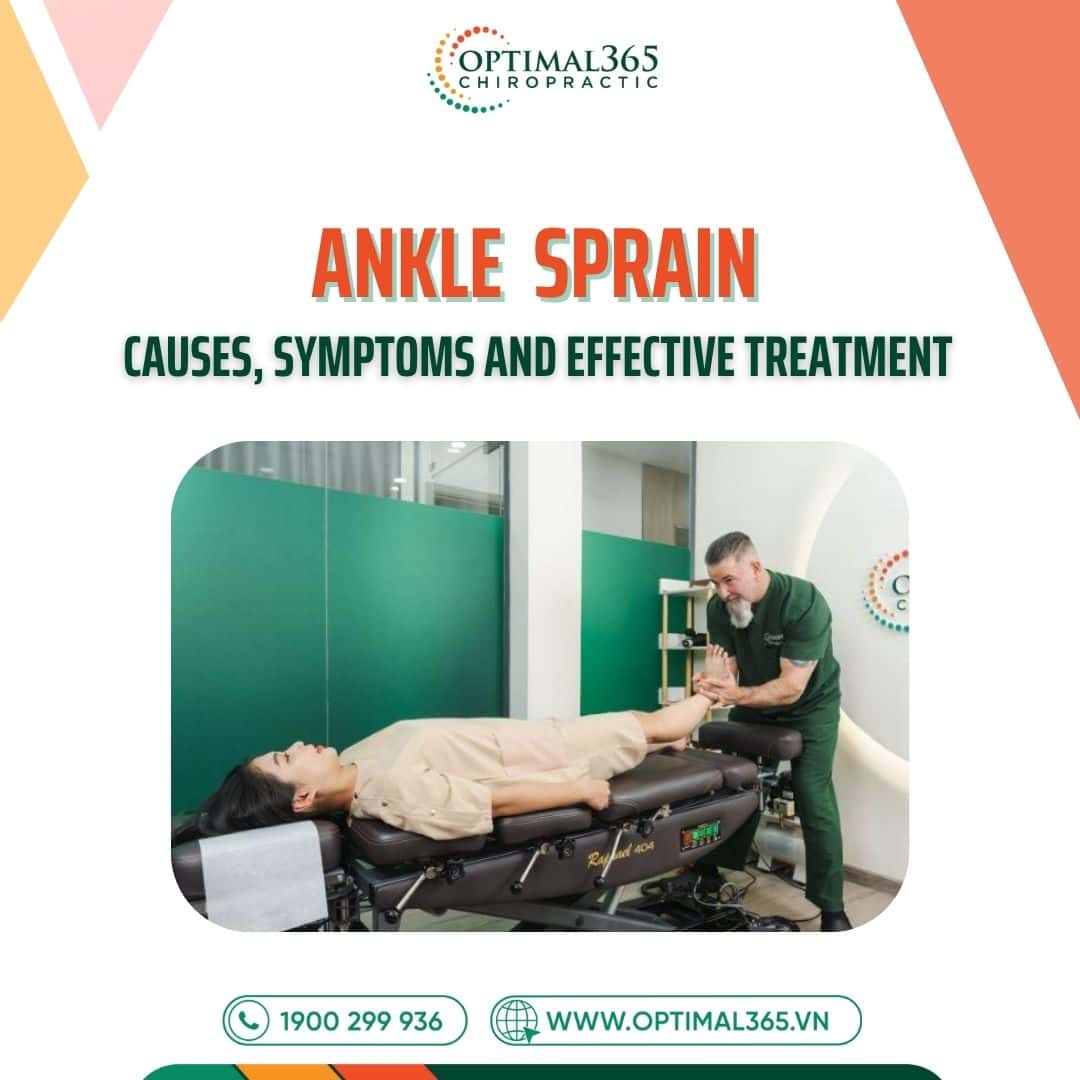An ankle sprain, a seemingly minor injury, can cause significant disruptions to daily activities. This condition is increasingly common, especially among young people and those who frequently engage in physical activities. Not only does it affect health, but an ankle sprain also reduces work efficiency and overall quality of life. So, what is an ankle sprain, what are its causes, and how can it be effectively prevented and treated? Let’s explore in this article.
What is an Ankle Sprain?
An ankle sprain is a condition involving damage to the ligaments surrounding the ankle joint, occurring when these ligaments are overstretched or torn. This injury typically results from strong impacts such as direct collisions, falls, or twisting the joint during movement.
The ankle joint ligaments play a crucial role in stabilizing and maintaining the ankle in its proper position. They are divided into two main groups:
- Lateral ankle ligaments: Including the anterior talofibular ligament, posterior talofibular ligament, and calcaneofibular ligament. These ligaments primarily support and secure the outer side of the ankle joint, helping maintain stability during everyday activities.
- Medial ankle ligaments: Including the deltoid ligament (also known as the delta ligament), divided into superficial and deep layers, responsible for stabilizing the inner side of the joint.
In practice, most cases of ankle sprain occur due to injury to the lateral ligament group, particularly the anterior talofibular ligament, making balance and movement difficult.
When moving the ankle joint, you may feel the joint becoming loose or unstable.

What is an Ankle Sprain?
Degrees of Ankle Sprain
Depending on the extent of the damage, ankle sprains are classified into three main levels:
- Mild degree (Grade 1): This is the mildest level of sprain, occurring when the ankle ligaments are slightly stretched due to moderate force. Symptoms include mild swelling and a dull ache at the injury site. Although ankle mobility is maintained, the individual may feel discomfort during movement.
- Moderate degree (Grade 2): At this level, the ankle ligaments are partially torn, leading to more pronounced swelling and possible bruising. The patient often experiences sharp pain and a sense of instability when standing or moving. Mobility is noticeably reduced compared to mild cases, hindering daily activities. Small blood vessels around the torn ligament rupture, causing subcutaneous bleeding that forms bruises.

Degrees of Ankle Sprain
- Severe degree (Grade 3): This is the most serious level of sprain, where the ankle ligaments are completely ruptured. The ankle area swells significantly and shows clear bruising, accompanied by intense pain. The patient is often unable to stand or move on the injured foot. This condition requires professional evaluation and treatment to ensure full recovery and prevent long-term complications.
What Causes Ankle Sprains?
Ankle sprain is a common injury that can arise from various causes, such as:
Ankle sprain occurs when landing incorrectly after jumping or performing sudden twisting movements. Exercising on uneven or unstable surfaces can increase the risk of sprain. Collisions during activities, such as stepping on someone else’s foot, can also lead to ankle sprain. Sprain can happen when the foot inverts (damaging the outer ligaments) or everts (damaging the inner ligaments). When the foot everts outward, the deltoid ligament is damaged, resulting in a sprain.

Factors that may increase the risk of ankle sprain include:
- Participating in sports: Sports like basketball, tennis, soccer, and trail running require frequent jumping and pivoting techniques.
- Activities on uneven terrain: Walking or running on rough surfaces or poor field conditions.
- History of ankle injury: Individuals with prior ankle injuries are at higher risk of recurrence.
- Poor physical condition: Reduced flexibility and strength in the ankle area increases sprain risk during sports.
- Wearing inappropriate shoes: Shoes that are the wrong size, unsuitable for sports, or frequent use of high heels can heighten the risk. Shoes that are too tight or too loose reduce joint stability, making the foot prone to slipping and twisting.

Signs of Recognizing an Ankle Sprain
An ankle sprain occurs when the ankle joint is subjected to abnormal strong forces (stretching, bending, twisting), damaging the surrounding ligaments. When sprained, the body exhibits several signs such as:
After the injury, you may hear a “pop” sound at the ankle joint, similar to cracking a finger knuckle. The ankle area will show bruising and swelling, with the degree varying by sprain severity. The joint is almost immobile during the injury. A persistent dull ache at the injured area, especially in severe sprains where pain intensifies with movement. In severe sprain cases, pain is more intense and worsens with movement.
Depending on the injury’s severity, treatment methods for ankle sprain will differ. However, self-treating at home without professional guidance can lead to undesirable consequences.
Particularly in severe sprains, if not diagnosed and treated promptly, it may cause complications like chronic ligament damage, reduced ankle mobility, or even early joint degeneration. Therefore, when experiencing an ankle sprain, consult a doctor for examination and appropriate treatment advice.

Methods to Diagnose Ankle Sprain
To diagnose an ankle sprain, the doctor will gather medical history and perform a direct examination of the ankle, foot, and related injuries. The evaluation includes tests like inversion, eversion, and anterior drawer to determine the extent of damage.
In severe injury cases, the doctor may order imaging tests for a more detailed assessment:
- X-ray: Helps rule out fractures and evaluate bone positions in the ankle area.
- MRI (Magnetic Resonance Imaging): Provides detailed cross-sectional images of soft tissues inside the ankle, including ligaments, to identify damage levels.
- Ultrasound: Allows quick and effective evaluation of ligament damage in the ankle.
- CT Scan: Offers detailed images of bones and joints in the ankle, helping assess injuries and surrounding structures more clearly.
Effective Treatment Methods for Ankle Sprain
The PRICE Method
In cases of ankle sprain, doctors recommend applying the PRICE method in the first 24-48 hours after injury. Specifically:
- P (Protection): Use a brace or crutches to protect the ankle, preventing further damage and reducing pressure on the injured area.
- R (Rest): Limit physical activities like running, jumping, or exercising to avoid worsening the injury.
- I (Ice): Apply ice packs to the ankle for 15-20 minutes, repeatable several times a day to reduce swelling and inflammation.
- C (Compression): Gently wrap the ankle with elastic bandages or use a brace for severe injuries to minimize swelling and support recovery.
- E (Elevation): When sitting or lying down, elevate the ankle above heart level to reduce swelling and improve circulation. Ice application constricts blood vessels, limiting blood flow to the injured area and thereby reducing swelling.

Using Pain Relievers
Pain relievers are an essential part of treating ankle sprain. Medications like ibuprofen, naproxen, and acetaminophen are used to alleviate pain and inflammation. Their mechanism inhibits prostaglandin synthesis—a potent inflammatory agent.
Note: However, self-medicating can lead to unwanted side effects. Patients should consult a doctor before use.
NSAIDs inhibit COX enzymes and reduce prostaglandin production.
Ankle Bracing
For severe ankle injuries (Grade III), patients need to immobilize the ankle with fabric braces or casts for 4-6 weeks to allow full ligament recovery. Starting movement too early after injury can lead to prolonged joint instability. This not only causes chronic mobility issues but also increases the risk of reinjury.
Conservative Treatment for Ankle Sprain at Optimal365 Chiropractic
Optimal365 Chiropractic offers conservative treatment services for ankle sprain to optimize recovery and deliver the best results for each client. Our international team of doctors from the US, with over 20 years of experience in Chiropractic, along with highly specialized technicians, ensures optimal diagnosis and treatment.
We apply advanced techniques such as electrical stimulation, high-power laser, tecar therapy, shockwave therapy, and laser treatment machines. These methods are not only safe but also provide clear effectiveness in pain reduction and functional recovery.

Ankle Sprain Treatment at Optimal365 Chiropractic
At Optimal365 Chiropractic, we understand that each client has unique health conditions. Therefore, every treatment protocol is customized to meet specific needs. Our doctors focus not only on symptom relief but also on identifying root causes, providing precise therapies to accelerate and enhance recovery. Clients will experience a comprehensive, professional, and dedicated treatment process at Optimal365 Chiropractic.
Surgery
In some severe ankle sprain cases, especially when conservative treatments like medications, joint immobilization, and physical therapy fail to yield significant improvement, surgery may be considered. The decision for surgery is typically made when the ankle joint remains unstable, causing chronic pain and significantly limiting patient activity. The goal of surgery is to reconstruct or repair damaged ligaments, stabilizing the ankle joint and minimizing risks of joint degeneration and other long-term complications.
Surgery is needed when ligaments are completely ruptured, causing severe joint instability.
Things to Avoid When Self-Treating Ankle Sprain
Here are things to avoid when self-managing an ankle sprain to prevent worsening:
- Do not use alcohol or hot compresses for massaging the injury: Both have high heat properties, which can increase blood flow when applied to a sprained area, causing more swelling and risking muscle atrophy or joint stiffness.
- Limit pain relievers or joint injections: Overuse can lead to side effects like stomach pain, liver, and kidney damage. These drugs only temporarily mask symptoms without addressing the root cause. While joint injections provide quick pain relief, overuse can cause serious complications, including joint inflammation, infection, and cartilage damage.
- Do not bandage the ankle too tightly or too loosely: The bandage should be firm enough to stabilize the joint but not so tight as to impede blood flow. If too loose, it won’t provide adequate support, increasing reinjury risk.
FAQ About Ankle Sprain
How Long Does an Ankle Sprain Typically Last?
Recovery time for ankle sprain depends on the damage level:
- Mild sprain (Grade 1): Usually takes 1-2 weeks.
- Moderate sprain (Grade 2): May require 3-6 weeks.
- Severe sprain (Grade 3): Can last from 6 weeks to several months, depending on injury extent and treatment.
When Should You See a Doctor for an Ankle Sprain?
If you have an ankle sprain, see a doctor immediately if signs like swelling and pain appear after trauma, collision, or fall. Especially if pain and swelling persist and intensify, this may indicate more serious damage like complete ligament rupture or ankle/lower leg fractures.
Timely examination and diagnosis allow accurate assessment, leading to suitable treatments that optimize recovery and minimize complications.
Which Degree of Ankle Sprain is the Most Dangerous?
Grade 3 ankle sprain, with complete ligament damage, is the most severe and poses significant dangers. When ligaments fully rupture, the ankle loses stability, leading to serious consequences:
- The ankle becomes loose, prone to dislocations, causing pain and limited movement.
- Instability makes the ankle vulnerable to reinjury, especially in sports or vigorous activities.
- Prolonged damage can lead to arthritis, causing pain and stiffness.
- In severe cases, it may result in early joint degeneration, reducing quality of life.
Joint instability causes walking and movement difficulties, affecting work and daily activities.
To prevent these dangerous complications, Grade 3 ankle sprain patients need prompt diagnosis and treatment by specialists. Methods may include bracing, physical therapy, and in some cases, surgery to reconstruct ligaments.
Can an Ankle Sprain Heal on Its Own?
Most mild ankle sprains, involving only ligament stretching, can heal naturally with proper care. Apply the RICE principle (Rest, Ice, Compression, Elevation) to reduce swelling and pain.
However, for more severe cases like partial or complete tears, medical intervention is necessary to assess damage and create a tailored plan, possibly including physical therapy, bracing, or surgery.
Without proper and timely treatment, complications like chronic joint instability, arthritis, and early degeneration can occur.
Prevention Measures for Ankle Sprain
Effective ways to prevent ankle sprain include:
- Always warm up before exercising or sports to warm muscles, boost circulation, and minimize injury risk.
- Choose well-fitting shoes that support the ankle and suit the activity type. Specialized sports shoes better protect your feet.
- Avoid activities on uneven, slippery, or obstacle-filled surfaces.
- If you’ve had a prior sprain, use braces or wraps to protect the ankle during exercise.
- Regularly perform exercises to strengthen and improve flexibility in the muscles around the ankle.
With the information shared, Optimal365 Chiropractic hopes you now better understand the causes, symptoms, and effective treatments for ankle sprain. To protect ankle joint health, pay attention to posture during movement, choose suitable footwear, and don’t forget regular exercises to build muscle strength. If you’re facing ankle issues, seek consultation from Optimal365 Chiropractic doctors for timely diagnosis and treatment.
Reference source:
1. American Academy of Orthopaedic Surgeons. (n.d.). Sprained ankle. https://orthoinfo.aaos.org/en/diseases--conditions/sprained-ankle/
2. American Academy of Orthopaedic Surgeons. (n.d.). Ankle fractures (broken ankle). https://orthoinfo.aaos.org/en/diseases--conditions/ankle-fractures-broken-ankle/
3. Merck Manual. (n.d.). Overview of sprains and other soft-tissue injuries. https://www.merckmanuals.com/professional/injuries-poisoning/sprains-and-other-soft-tissue-injuries/overview-of-sprains-and-other-soft-tissue-injuries#v13386203
4. National Institute of Arthritis and Musculoskeletal and Skin Diseases. (n.d.). Sprains and strains. https://www.niams.nih.gov/health-topics/sprains-and-strains#tab-overview
5. Papadakis, M. A., McPhee, S. J., & Bernstein, J. (2021). Quick medical diagnosis & treatment. McGraw Hill. https://accessmedicine-mhmedical-com.ccmain.ohionet.org/content.aspx?bookid=2986§ionid=251086882
6. Previti, R. (2024, January 10). How long does a sprained ankle take to heal and other questions. EmergeOrtho. https://emergeortho.com/news/how-long-do-sprained-ankles-last/
7. Mayo Clinic. (2022, August 11). Sprained ankle – Symptoms and causes. https://www.mayoclinic.org/diseases-conditions/sprained-ankle/symptoms-causes/syc-20353225











